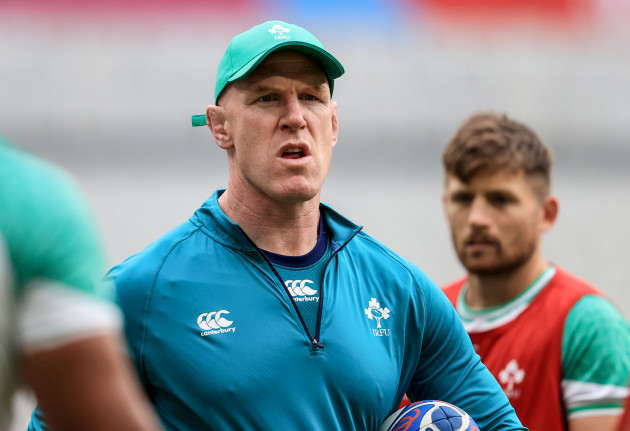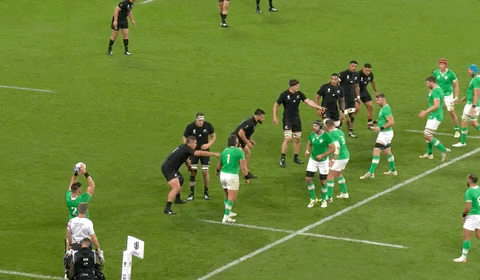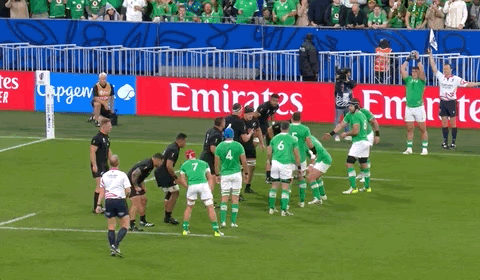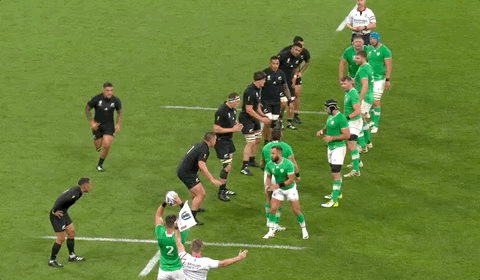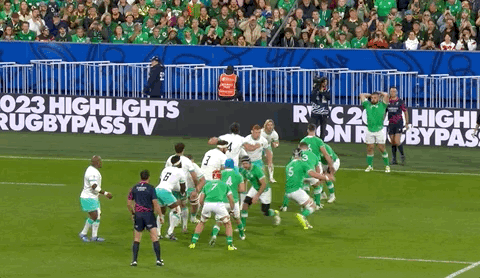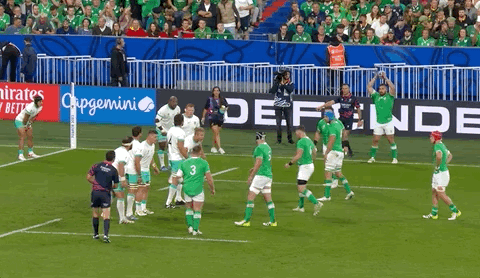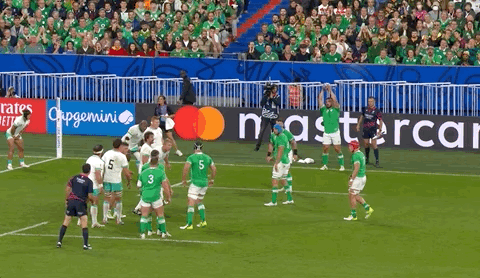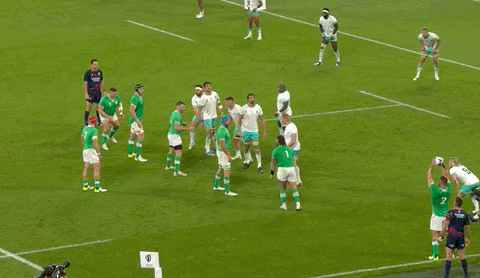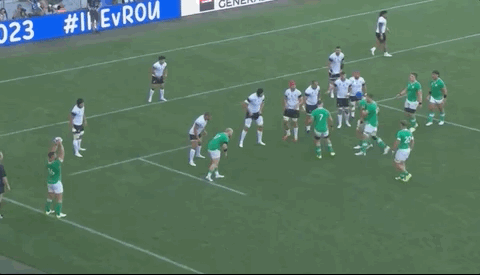HAD JORDIE BARRETT been unable to prevent Rónan Kelleher from grounding the ball in the 72nd minute last weekend in Paris, then Ireland’s lineout and maul would have been hailed as one of the key reasons Andy Farrell’s side reached the semi-finals.
That’s how fickle sport can be.
Ireland had already scored a thunderous maul try seven minutes before Kelleher was held up. On that first occasion, Tadhg Beirne claimed Kelleher’s throw under pressure from Sam Whitelock, Ireland shifted their drive to the left, and blasted their way towards the line.
There seemed to be only one possible outcome when Codie Taylor hauled it down illegally, ensuring referee Wayne Barnes went under the posts to award the penalty try and Taylor went to the sin bin for 10 minutes. It was a satisfying score for the Irish pack.
Second time around, Ireland nailed their lineout drill again as Kelleher connected with Beirne. The Irish pack once again shifted left and made progress, before being slowed slightly. But the Irish forwards spun left again and Kelleher catapulted himself towards the tryline only to be stopped by Barrett.
But for Barrett getting his leg under the ball, Ireland forwards coach Paul O’Connell would probably have been hailed as the genius behind two brilliant maul tries that helped Ireland to make history.
That’s how these things work. Barrett held the ball up and the reality now is that O’Connell’s work as Ireland’s forwards coach is being questioned after they lost three of their 14 throws into the lineout last weekend.
Ireland were 100% against Scotland a week earlier but down at 67% on their throw in the pool-stage win over the Springboks. Against Tonga, Ireland ran their lineout at 91% success and in the first pool game against Romania, it was also down at 67%.
So it’s fair to say that there was inconsistency in the Irish lineout at the World Cup, with their overall 82.5% lineout success leaving them ranked 13th out of 20 teams in the tournament, according to Opta’s data. That’s certainly not the return that O’Connell and co. would have wanted.
It’s also a dip from the 85.7% success rate Ireland had during this year’s Six Nations, which left the Irish lineout ranked fourth of the six teams in the championship.
However, Ireland’s lineout defence was strong in this World Cup. Only England, South Africa, and New Zealand made more lineout steals than Ireland’s 12, while only Argentina had a higher percentage of steals on the opposition throw. Ireland picked off 24.5% of their opposition’s lineouts.
That was a continuation of Ireland’s defensive strength in the Six Nations, when they picked off a higher percentage of opposition throws than anyone else at 18.6% [11 steals].
The lineout is pivotal to any team as an attacking platform and even more so for Ireland.
44.6% of all tries scored at this World Cup have started at the lineout, according to Opta.
But 56.7% of Ireland’s tries started with their own throw into the lineout. That underlines how important it is for Farrell’s team to have a high-functioning lineout from which they can build dangerous attacks.
One of the big frustrations for Ireland has been that many of their lineout losses in this World Cup have come in promising areas.
Now, it’s worth underlining that losing lineouts in your own 22 is potentially catastrophic. There’s nowhere ‘good’ to lose a lineout, but coughing up turnovers in the attacking third of the pitch can be damaging.
In the example below, Ireland get picked off by Shannon Frizell just inside the New Zealand 22.
Ireland are 13-3 down in the 25th minute here, so it’s obviously not ideal, but they do actually get the ball back around five seconds later as Richie Mo’unga’s attempted clearance is blocked by Caelan Doris and Tadhg Beirne wins the scraps.
Still, when you have a lineout in a position like this, you want to be able to execute the plans you’ve been working on. It’s clearly an excellent steal from Frizell here as he decides to jump even before Ireland have moved in their own lineout.
It was Ireland’s second lineout loss of the evening, although the first one also saw them retain possession.
Ireland look to jump just in behind Brodie Retallick, who gets a remarkable leap and lift to get a hand to the ball. Ireland lineout leader Iain Henderson goes from lifting Peter O’Mahony to batting the ball back onto Ireland’s side and they can attack seemingly as if they’d won the ball clean.
A geniune turnover at the lineout later in the half proved to be very costly.
In this instance, Ireland ‘win’ the lineout as Doris bats it back on their side, but New Zealand gather the loose ball. It goes down as Ireland winning the lineout in the official stats but that’s not really the case.
Directly from this turnover, Will Jordan kicks a brilliant 50:22 as Ireland scramble to react to turning the ball over. From the resulting lineout, New Zealand score their second try.
There’s obviously a few important pieces in between the lineout loss and Ardie Savea dotting down in the right corner, but that’s how costly these moments can be at set-piece time.
Those three examples aside, Ireland’s lineout was faultless against New Zealand.
“There was two or three lineouts that went astray, but we know that they’re a good lineout D team,” said lineout caller Henderson.
“Roughly, on average, a good defence takes about 20% of ball off an opposition and you’ve got to realise that when you are playing a side like New Zealand, who are a world-class side, they are going to win some lineouts. It’s about resetting and trying to win the next one and, at times, we did that very well.”
Forwards coach O’Connell admitted that the third lineout loss had been damaging.
“They’re a good defensive lineout, New Zealand,” said O’Connell. “I think we have the best defensive lineout, they might be the second best.
“They guessed right on two of them. They didn’t really hurt us that much but then they got a hand to another one which got spilled and then they got the field position and scored a try off that. So that was frustrating. There was a lot of very good things in our lineout but we’ll look back on those three and regret them for a while, maybe.”
Ireland do generally have a strong defensive lineout, but they weren’t able to come up with any steals in this clash with New Zealand.
The Kiwis ran at 100% lineout on their eight throws, meaning they’re now at an impressive 98.1% success rate during the World Cup, the best in the tournament.
New Zealand have lost just one lineout on their own throw, while stealing 17 of the opposition throws, which is joint-top with South Africa.
Henderson was Ireland’s lineout leader against Scotland and New Zealand, with James Ryan having been in that role for the matches against Romania, Tonga, and South Africa.
They’re both known as studious, hard-working lineout operators who do lots of analysis and work closely with O’Connell to come up with lineout ‘menus’ for each game – choosing which lineout calls from their playbook are ideally suited to the match ahead.
Ireland’s lineout losses against South Africa didn’t end up being the deciding of that game, but they easily could have been in a tense, tight battle in Paris.
They lost their first four lineouts of the game, all of them inside the opening 11 minutes and all of them inside the Springboks half. The first came after just 46 seconds.
Again, Ireland react well to the steal by Springboks lock Franco Mostert, with Ryan intercepting his pop towards hooker Bongi Mbonambi. Ireland are able to attack and win a penalty that they kick into touch for another lineout.
This time, the Boks get a pivotal clean steal.
Ireland were aggrieved about this Boks steal. Watch how Steven Kitshoff moves from the receiver position into the front of the lineout to lift Pieter-Steph du Toit while Frans Malherbe [number 3] still hasn’t actually left it.
The Boks have an extra man in the lineout, which is against the laws. But it’s subtle, smart play from the South Africans as they take a punt and get away with it.
Another few minutes later, another Irish lineout loss just outside the 22.
This time, Ryan is adjudged to have knocked the ball on under pressure from the Boks, who get two jumpers into the air as they continue their aggressive defence at the lineout.
And just three minutes later, another lineout loss for Ireland in the Boks 22.
Ireland had two further losses at the lineout in that Boks game, with Kelleher throwing crooked in the Irish half at one stage, then Mostert picking off another Irish lineout in the 22 later in the second half.
Even more frustratingly, the loss above came just after O’Mahony had forced a turnover from the Springboks lineout.
The Boks also threw crooked into a lineout five metres out from Ireland’s tryline later in the game in what was a crucial moment.
All in all, it was a poor outing for the Irish lineout, albeit we should mention that they had a high number of lineouts in this Boks match with 18 of their own throws. Indeed, Ireland had more lineouts than any other team in the World Cup apart from Fiji. Ireland’s 80 lineouts was considerably higher than, say, New Zealand who had only 52.
Ireland won 66 of them but lost 14 of their own throws, not including that bat back against New Zealand that ended up in Kiwi hands.
The other poor Irish lineout performance was in the opening game against Romania when they lost four of their own throws.
Twice, the Romanians made steals in the air, Rob Herring threw in crooked once, and the fourth loss came close to the tryline.
These are the kind of moments that will rankle with O’Connell in his review of the Irish forwards’ performance at this World Cup.
Of the 14 lineout losses in recent weeks, 12 were in the opposition half.
10 were inside or just outside the opposition 22 and that leaves Ireland with plenty of work to do when they start looking towards the Six Nations in the coming months.


